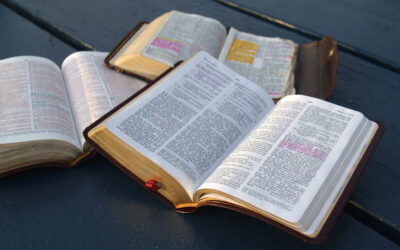The Hebrew root for blessing is brk. From this word, we get two words – berekh and barakh. Berekh refers to the knee. It is often used to refer to the knee joint on which we kneel (e.g. Judges 7:5). It is situated in between the loins and ankles (Ezekiel 47:4). In some contexts, the word may also be used to refer to the lap (e.g where a child sits) (2 Kings 4:20). The word barakh, on the other hand, means blessing. It can be both a noun (berakhah) and a verb (barakh).
What Does the Hebrew Word for Blessing Mean?
Hebrew scholars believe there is a connection between brk (the root word for blessing) and prq (which means to break). Since the knee is the place where the joint “breaks”, it makes sense that the two words would be related. Besides, homage was traditionally rendered on a bended knee and this is another illustration of how the two words are connected. This however introduces two directions of blessing – with one type of blessing coming from God towards man and the other coming from man towards God.
Bowing the Knee
The relationship between the blessing and the knee is made evident in childbirth. Children are described as being born at the knees of the mother (Job 3:12). We also know from several places in scripture that children as a blessing from God. As such, it would be accurate to interpret the blessing described in places like Genesis 49:8 as “placing on the knee of.” In this context, Joseph places his sons at the knees of Jacob to illustrate that they are candidates for the blessing.
The Genesis account of creations also demonstrates this timeless truth. As God continues with his work of creation, he breathes life into the creation by pronouncing blessings upon flora and fauna. Check it out;
And God blessed them, saying, Be fruitful and multiply and fill the waters in the seas, and let birds multiply on the earth. Gen.1:22
By pronouncing a blessing upon them, God was imbuing his creation with the capacity to reproduce (or bear children at their knees) and thereby continue with his work of creation. Childbirth therefore becomes a demonstration of the blessing of God since it was the blessing that was transmitted from God (the greater) to his creation (the lesser). This is in line with the summary that was given in Hebrews 7:7 (the lesser is blessed by the greater).
Humans have also demonstrated the connection between the blessing and the knee by paying homage through bowed knees. For instance, Abraham and Jacob “fell on their faces” before God (Genesis 17:3, 28:12), acknowledging their dependence and seeking His blessing. Such an act is not just a physical expression but an inward bending of the heart as a way of aligning with the divine will. When one submits to God in such a way, one can expect to be a beneficiary of his blessing.
The Reciprocity of Blessing
The Hebrew understanding of blessing isn’t unidirectional. While God bestows blessing upon His creation, we are also called to be agents of blessing. Jacob, blessed at his father’s knee, later blesses his own sons by placing them at the knees of his grandfather, Isaac (Genesis 48:14). This act exemplifies the cyclical nature of blessing, where divine favor flows through human hands, rippling outward in generosity and love.
Another illustration of this can be found in the Abrahamic blessing. After God calls Abraham and blesses him, he tells him that he would not only be blessed but that he would also be a blessing. God promises him that the nations of the world will be blessed through him.
But perhaps the most incredible demonstration of the reciprocity of the blessing is when man blesses God. For instance, the Psalmist says to “bless the Lord” (Psalms 103:1). In the book of Revelation, John saw angles and the living creatures in heaven declaring that the Lord was worthy to receive blessing (Rev. 5). The connotation of the word blessing in these and many other similar instances in the Bible is that of worship. It correlates to the meaning of bending the knee as a way of paying homage.
An Empowerment
Blessing as an empowerment is the most common use of the word both in scripture as well as in modern terms. We can trace the origin of this meaning to the first chapter of Genesis in the creation account. After God created man, scripture says that he blessed him.
Then God blessed them, and God said to them, “Be fruitful and multiply; fill the earth and subdue it; have dominion over the fish of the sea, over the birds of the air, and over every living thing that moves on the earth. Gen. 1:28
In this context, the blessing was an empowerment from God the creator. It was as a result of the blessing that man could fulfill his mandate to be fruitful, multiply, subdue, and have dominion over all creation. This is the type of blessing that Hebrews 7:7 refers to because it can only be from a greater towards a lesser. If we look at it in the context of the Hebrew root word (brk), man bows his knee before the creator who then blesses him (empowers him to prosper).
Conclusion
As we have seen, the Hebrew word for blessing is based on the root word brk which forms the words berekh and barakh. On the surface, these two words seem unrelated since one talks about the knee while the other talks about the blessing. However, a closer examination reveals that the two are correlated. For one to be blessed, they will need to submit their will to the will of the one blessing them. Metaphorically speaking, they will need to bow their knee. Scripture has also created a link between the knee to childbirth by saying that children are born at the knees of their mothers. By so doing, scripture emphasizes the relationship between the knee and the blessing, since children are a blessing from the Lord.





